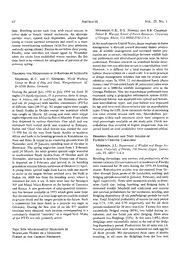
Tracking the migrations of 30 raptors by satellite PDF
Preview Tracking the migrations of 30 raptors by satellite
62 Abstracts VoL. 29, No. 1 base. Breeding occurs each year with equal success in Moorman, C.E., D.L. Howell and B.R. Chapman either male or female ‘owned’ enclosures. An alternate Daniel B. Warnell School ofForest Resources, University corridor route, opened each September, allows flighted of Georgia, Athens, GA 30602-2152 US.A. young to vacate parental territories and travel to a more Inthe southeastern United States, majoremphasis in forest remote overwintering enclosure (with live prey predation management is directed toward increased timber produc- and early spring release). Parents do not follow their young. tion. If wildlife management and increased timber pro- Finally, most corridors are closed again by November duction are to coexist, relationships between wildlife hab- when the adults have established winter routines. By this itat preferences and silvicultural practices must be better time there is no evidence for recognition of partners of the understood. Previous research on woodland hawks deter- previous spring. mined that nest site selection occurs at amicrohabitat level. However, it is difficult for a land manager to select for Tracking the Migrations of 30 Raptors by Satellite habitat characteristics on a small scale. It is more practical to design management schemes that aim for critical mac- Meyburg, B.-U. and C. Meyburg. World Working rohabitat types. In 1994, 12 red-shouldered hawk {Buteo Group on Birds of Prey and Owls, Wangenheimstr. 32, lineatus) and 10 red-tailed hawk {B jamaicensis) nestswere D-14193 Berlin, Germany . located on a 5000-ha wildlife management area in the During the period July 1992 to July 1994 we fitted 30 Georgia Piedmont. Nest site macrohabitat preferences were eagles (10 Aquilanipalensis, \0 A.pomarina, threeA. clanga, examined using a geographic information system (GIS). four A. heliaca, one A. wahlbergi, one Haliaeetus albicilla Hardwood habitat was separated into upland and bottom- and one H. pelagicus) with satellite transmitters (PTTs) land macrohabitat types, and pine habitat was separated of different sizes (28-95 g). All steppe eagles were caught by age and structural characteristics into six macrohabitat m Saudi Arabia in October except one immature which types. Using the GIS, three concentric circles ofincreasing was caught in March. All young and most adult steppe size were created around each nest. Macrohabitat per- eaglesmigrated intoAfricavia Bab el Mandeb. From there centages within each concentric circle were compared to they dispersed in various directions. One adult and one total percentages available on the study area. Circle ma- immature bird turned north and wintered in Ethiopia, crohabitats that occurred in higher proportions than ex- Sudan and Chad. One adult female was tracked for over pected based on total availability were considered critical. 15 000 km all the way from Saudi Arabia to southern Africa and back to its breeding grounds in Kazakhstan via Breeding Biology and Nest Success of Suez and Eilat. It stayed in its wintering grounds from 22 Florida’s Crested Caracaras November until 29 January, spending most of the time in Morrison, J.L. Department of Wildlife and Range Sci- Botswana. The spring migration lasted from 1 February ences, University ofFlorida, 118 Newins-Ziegler, Gaines- until 24 March. An adult greater spotted eagle wintered ville, FL 32611 U.S.A. in southwestern Saudi Arabia from 29 October until 24 November, afterwards in northern Yemen east of Saana. Breeding chronology, nest success, and productivity ofthe It departed on 2 February and arrived in its breeding crested caracara (Caracaraplancus) in southcentral Florida grounds in western Siberia northwest ofOmsk on 21 April. were examined for 28 nests during the 1993-94 breeding A young lesser spotted eagle from Latvia took one month season. Reproductive activity was documented from Oc- to arrive in the largest African wetland area, the Sudd in tober through June; peaks of the incubation, nestling, and Sudan (ca. 6000 km from the breeding area), where it fledging periods occurred in January, February, and early remained for over 6 wk. It then went into the Serengeti April respectively. Nests were monitored weekly to deter- NP and Masai Mara Reserve on the border of Tanzania mine clutch size, laying, hatching, and fledging dates. I and Kenya. A new generation of solar-powered transmit- estimated weekly Mayfield and traditional nest success ters has become available in 1993 which gives some hope and survival probabilities for the incubation, nestling, and that the movements ofatleast large species could be studied fledgling dependency (8 wk postfledging) periods for each in greater detail and for longer periods in the future. Such nest. Total Mayfield probability of success for each period a transmitter has been fitted to a juvenile sea eagle in was 0.74, 1.00, and 0.90 respectively and for all three Germany. During the first year of its life 877 satellite periods combined for 28 nests was 0.66. Twenty-five nests locations were obtained, each location corresponding to a successfully fledged young (89%), two failed during in- customarily obtained “recovery” of a ringed bird. Many cubation, and one failed just after fledging. Most nests of the PTTs are still presently active. produced two fledglings (53%). At five nests (18%), three fledglings were successfully raised to the end of the fledg- ling dependency period. Productivity for all nests was 1.6. Nest Site Macrohabitat Selection by Survival probabilities were also estimated for each egg for Woodland Hawks on a Managed all three periods. We documented three cases of double Forest in the Georgia Piedmont brooding; in all cases the fledglings from the first nest
